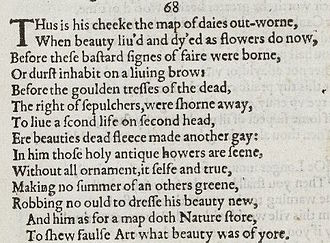Sonnet 68
« » Sonnet 68 | |||||||
|---|---|---|---|---|---|---|---|
 Sonnet 68 in the 1609 Quarto | |||||||
 | |||||||
| |||||||
Sonnet 68 is one of 154 sonnets written by the English playwright and poet William Shakespeare. It is a member of the Fair Youth sequence, in which the poet expresses his love towards a young man.
Structure
Sonnet 68 is an English or Shakespearean sonnet. The English sonnet has three quatrains, followed by a final rhyming couplet. It follows the typical rhyme scheme of the form, abab cdcd efef gg and is composed in iambic pentameter, a type of poetic metre based on five pairs of metrically weak/strong syllabic positions. The second line exemplifies a regular iambic pentameter:
× / × / × / × / × / When beauty lived and died as flowers do now, (68.2)
- / = ictus, a metrically strong syllabic position. × = nonictus.
The scansion of the eighth line is ambivalent. Normally the words "dead fleece" would have the stress of "dead" subordinated to that of "fleece", allowing them comfortably to fill × / positions, not / ×. However, if accent is placed on "dead", a regular scansion emerges:
× / × / × / × / × / Ere beauty's dead fleece made another gay: (68.8)
Alternatively, "fleece" can maintain the greater stress, suggesting this scansion:
× / × / / × × / × / Ere beauty's dead fleece made another gay: (68.8)
A reversal of the third ictus (as shown above) is normally preceded by at least a slight intonational break, which "dead fleece" does not allow. Peter Groves calls this a "harsh mapping", and recommends that in performance "the best thing to do is to prolong the subordinated S-syllable [here, "dead"] ... the effect of this is to throw a degree of emphasis on it".[2]
Notes
Further reading
- Groves, Peter (2013), Rhythm and Meaning in Shakespeare: A Guide for Readers and Actors, Melbourne: Monash University Publishing, ISBN 978-1-921867-81-1
- First edition and facsimile
- Shakespeare, William (1609). Shake-speares Sonnets: Never Before Imprinted. London: Thomas Thorpe.
- Lee, Sidney, ed. (1905). Shakespeares Sonnets: Being a reproduction in facsimile of the first edition. Oxford: Clarendon Press. OCLC 458829162.
- Variorum editions
- Alden, Raymond Macdonald, ed. (1916). The Sonnets of Shakespeare. Boston: Houghton Mifflin Harcourt. OCLC 234756.
- Rollins, Hyder Edward, ed. (1944). A New Variorum Edition of Shakespeare: The Sonnets [2 Volumes]. Philadelphia: J. B. Lippincott & Co. OCLC 6028485. — Volume I and Volume II at the Internet Archive
- Modern critical editions
- Atkins, Carl D., ed. (2007). Shakespeare's Sonnets: With Three Hundred Years of Commentary. Madison: Fairleigh Dickinson University Press. ISBN 978-0-8386-4163-7. OCLC 86090499.
- Booth, Stephen, ed. (2000) [1st ed. 1977]. Shakespeare's Sonnets (Rev. ed.). New Haven: Yale Nota Bene. ISBN 0-300-01959-9. OCLC 2968040.
- Burrow, Colin, ed. (2002). The Complete Sonnets and Poems. The Oxford Shakespeare. Oxford: Oxford University Press. ISBN 978-0192819338. OCLC 48532938.
- Duncan-Jones, Katherine, ed. (2010) [1st ed. 1997]. Shakespeare's Sonnets. Arden Shakespeare, third series (Rev. ed.). London: Bloomsbury. ISBN 978-1-4080-1797-5. OCLC 755065951. — 1st edition at the Internet Archive
- Evans, G. Blakemore, ed. (1996). The Sonnets. The New Cambridge Shakespeare. Cambridge: Cambridge University Press. ISBN 978-0521294034. OCLC 32272082.
- Kerrigan, John, ed. (1995) [1st ed. 1986]. The Sonnets ; and, A Lover's Complaint. New Penguin Shakespeare (Rev. ed.). Penguin Books. ISBN 0-14-070732-8. OCLC 15018446.
- Mowat, Barbara A.; Werstine, Paul, eds. (2006). Shakespeare's Sonnets & Poems. Folger Shakespeare Library. New York: Washington Square Press. ISBN 978-0743273282. OCLC 64594469.
- Orgel, Stephen, ed. (2001). The Sonnets. The Pelican Shakespeare (Rev. ed.). New York: Penguin Books. ISBN 978-0140714531. OCLC 46683809.
- Vendler, Helen, ed. (1997). The Art of Shakespeare's Sonnets. Cambridge, Massachusetts: The Belknap Press of Harvard University Press. ISBN 0-674-63712-7. OCLC 36806589.
- v
- t
- e

| Plays |
|
|---|---|
| Poems |
and works
| Institutions |
|---|
- Anne Hathaway (wife)
- Susanna Hall (daughter)
- Hamnet Shakespeare (son)
- Judith Quiney (daughter)
- Elizabeth Barnard (granddaughter)
- John Shakespeare (father)
- Mary Arden (mother)
- Gilbert Shakespeare (brother)
- Joan Shakespeare (sister)
- Edmund Shakespeare (brother)
- Richard Shakespeare (grandfather)
- John Hall (son-in-law)
- Thomas Quiney (son-in-law)
- ✻ Shakespeare and other authors
- † Lost
 Category
Category WikiProject
WikiProject











